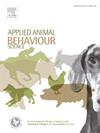延迟行为康复开始对收容所狗的恐惧和结果测量的影响
IF 2
2区 农林科学
Q1 AGRICULTURE, DAIRY & ANIMAL SCIENCE
引用次数: 0
摘要
未社会化的家养狗(Canis lupus familiaris)在面对日常刺激时经常经历中度到重度的恐惧,它们的福利可能会受到影响。在动物收容所的环境中,恐惧的行为也会减少狗被收养的机会,从而增加人道安乐死的风险。鉴于狗通常是由于恐惧相关的行为而被送到收容所的,因此需要研究评估行为矫正治疗对收容所环境中社会化不足的恐惧狗的效果。由于狗狗在被收容后适应收容所的过程中可能会表现出行为上的变化,因此此类研究必须从结构化治疗方案的影响中分析出适应的影响。这项实验研究考察了在接受行为矫正治疗后不久开始的狗的恐惧行为的变化,以及在治疗开始前经历两到四周“适应”期的狗的恐惧行为的变化。我们还比较了延迟治疗组的关键结果指标,包括治疗周数(WIT)、从行为矫正计划(TTG)毕业的总时间、毕业的狗的比例和被收养的狗的比例。两组被送往行为康复中心的狗(新泽西州[NJ]设施n = 260,北卡罗来纳州[NC]设施n = 114)被伪随机分为立即、两周和四周延迟行为矫正治疗开始组。所有的狗都接受了标准的收容所护理和狗窝强化,行为矫正治疗,减少焦虑的药物治疗,以及反复的行为评估,以评估宠物狗在家庭环境中遇到的几种日常刺激的恐惧。与延迟治疗组的狗相比,立即治疗组的狗表现出更快的恐惧减少,这表明行为改变,而不是对收容所环境的适应,导致了恐惧的减少。延迟治疗开始导致NJ组狗的WIT降低,而NC组没有。在立即治疗组和延迟治疗组之间,TTG没有观察到差异。治疗开始不影响毕业或收养狗的比例。虽然延迟治疗开始的狗的WIT略低,但立即治疗开始更迅速地减少了狗的恐惧。因此,如果住房资源允许,考虑到生活质量,尽早开始行为矫正可能是最合乎道德的选择。本文章由计算机程序翻译,如有差异,请以英文原文为准。
The impact of delaying behavior rehabilitation onset on fear and outcome measures in dogs in a shelter setting
Undersocialized domestic dogs (Canis lupus familiaris) often experience moderate to severe fear in response to everyday stimuli, and their welfare may suffer. In an animal shelter setting, fearful behavior can also reduce dogs’ chances of adoption and, thus, increase the risk of humane euthanasia. Given that dogs are commonly relinquished to shelters as a result of fear-related behaviors, research is needed to assess the efficacy of behavior modification treatment for undersocialized fearful dogs in the shelter environment. Because dogs may demonstrate behavior change as they acclimate to the shelter after intake, such research must parse out the effects of acclimation from those of a structured treatment protocol. This experimental study examined the change in the fearful behavior of dogs that had behavior modification treatment beginshortly after intake with that of dogs that experienced a two or four-week “settling in” period before treatment began. We also compared the delayed treatment groups by key outcome measures including weeks in treatment (WIT), overall time to graduation from the behavior modification program (TTG), proportion of dogs graduated, and proportion of dogs adopted.
Two cohorts of dogs (New Jersey [NJ] facility n = 260, North Carolina [NC] facility n = 114) admitted to a behavioral rehabilitation center were pseudo-randomized into behavior modification treatment onset groups of immediate, two-, or four-week delay. All dogs received standard shelter care and in-kennel enrichment, behavior modification treatment, anxiety-reducing medication, and repeated behavior evaluations to assess their fear of several everyday stimuli that pet dogs encounter in home environments. Dogs in the immediate onset treatment group demonstrated a quicker reduction in measures of fear compared to dogs in the delay groups, suggesting that behavior modification, not acclimation to the shelter environment, resulted in the reduction in fear. Delaying treatment onset resulted in lower WIT for dogs in the NJ cohort, but not the NC cohort. No differences were observed in TTG between immediate treatment and delay groups. Treatment onset did not affect the proportion of dogs graduated or adopted. While WIT were slightly lower for dogs with delayed treatment onset, immediate treatment onset reduced dogs’ fear more expeditiously. Therefore, if shelter resources allow, starting behavior modification as soon as possible may be the most ethical option, with quality of life in mind.
求助全文
通过发布文献求助,成功后即可免费获取论文全文。
去求助
来源期刊

Applied Animal Behaviour Science
农林科学-行为科学
CiteScore
4.40
自引率
21.70%
发文量
191
审稿时长
18.1 weeks
期刊介绍:
This journal publishes relevant information on the behaviour of domesticated and utilized animals.
Topics covered include:
-Behaviour of farm, zoo and laboratory animals in relation to animal management and welfare
-Behaviour of companion animals in relation to behavioural problems, for example, in relation to the training of dogs for different purposes, in relation to behavioural problems
-Studies of the behaviour of wild animals when these studies are relevant from an applied perspective, for example in relation to wildlife management, pest management or nature conservation
-Methodological studies within relevant fields
The principal subjects are farm, companion and laboratory animals, including, of course, poultry. The journal also deals with the following animal subjects:
-Those involved in any farming system, e.g. deer, rabbits and fur-bearing animals
-Those in ANY form of confinement, e.g. zoos, safari parks and other forms of display
-Feral animals, and any animal species which impinge on farming operations, e.g. as causes of loss or damage
-Species used for hunting, recreation etc. may also be considered as acceptable subjects in some instances
-Laboratory animals, if the material relates to their behavioural requirements
 求助内容:
求助内容: 应助结果提醒方式:
应助结果提醒方式:


